There’s no doubt that artificial intelligence (AI) is changing our world, from revolutionizing industry to transforming daily life, and reshaping the way we work, interact, and solve problems.
The global AI market has an estimated value of $136.55 billion in 2022 and is predicted to grow at a CAGR of 37.3% from 2023 to 2030. Furthermore, 94% of business leaders believe AI will be critical to their success. In fact, the consequences of the advancement of AI are so far-reaching they’ve been likened to a new industrial revolution.
Automated planning is one branch of AI that continues to evolve rapidly, driven by advances in machine learning and computing power. From managing tasks and schedules to controlling robots and autonomous vehicles, its applications are wide and varied.
This article will discuss what automatic planning is, how it works, its applications, and its potential for transformational change in business.
What is automated planning?
The business world has been quick to catch on to the potential of AI. Its uptake has been rapid and increases year by year. As the abilities of AI increase at an unprecedented rate, so too does its potential to bring about transformational change. AI technologies are being employed to automate tasks, analyze vast amounts of data, refine decision-making processes, improve customer experiences, and unlock new possibilities for growth and efficiency.
Businesses that are already investing in AI technology tend to increase their spending on it in the following years.
In 2018, 40% of respondents already using AI said that more than 5% of their digital budget went to AI, while in 2022, this figure rose to 52%.
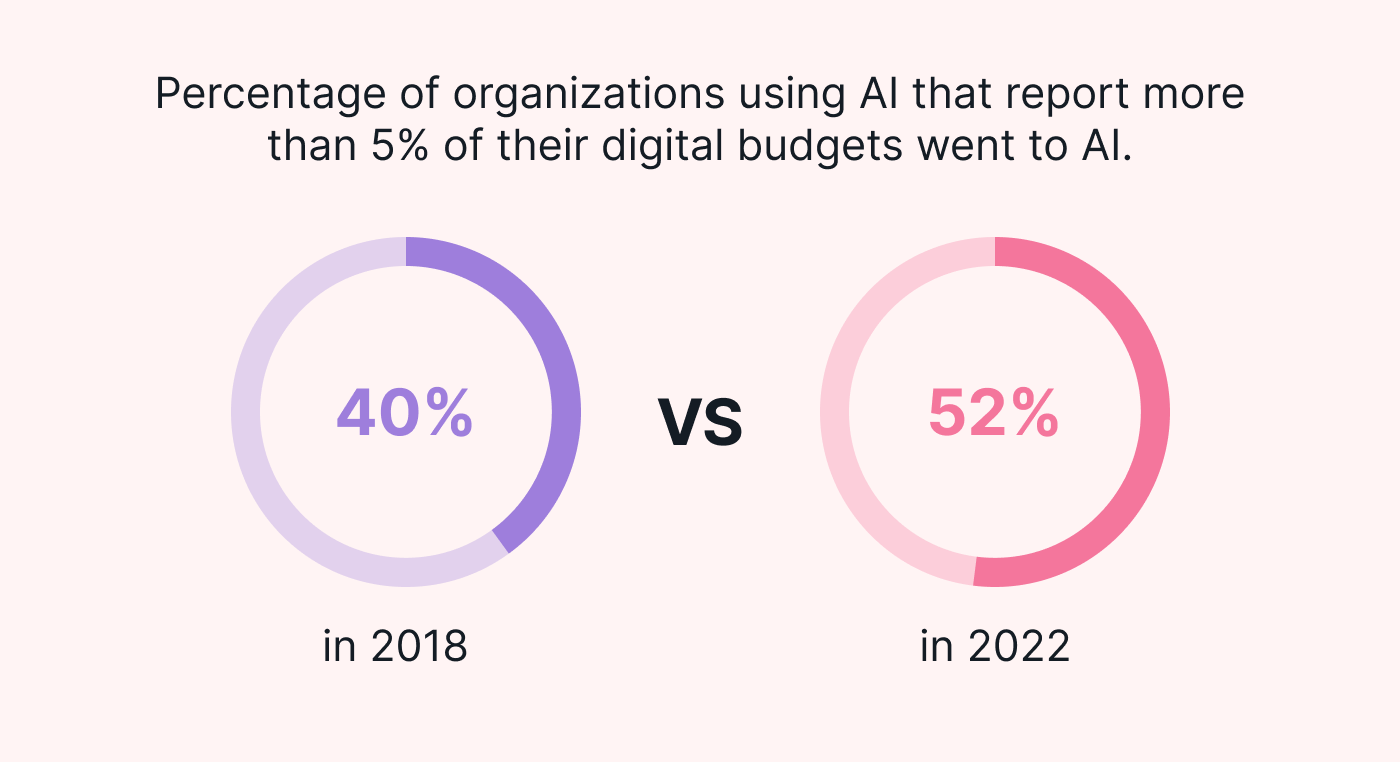 |
So it seems that those who use AI in some capacity see enough value in its worth to continue to invest and also to increase the proportion of their budget invested in AI. This seems good evidence to validate the idea that AI is of great benefit to businesses.
There are many ways in which AI can be employed, such as natural language processing (NLP), machine learning (ML), computer vision, virtual assistants, and data analysis and insights. In this article, we’re going to hone in on one particular branch of AI, which is automated planning.
Automated planning refers to the use of artificial intelligence and computer algorithms to solve problems by generating plans or sequences of actions. It's also sometimes called AI planning. We’ll delve a little deeper into how it works later.
Automated planning technology is involved in many AI-assisted business operations, for instance:
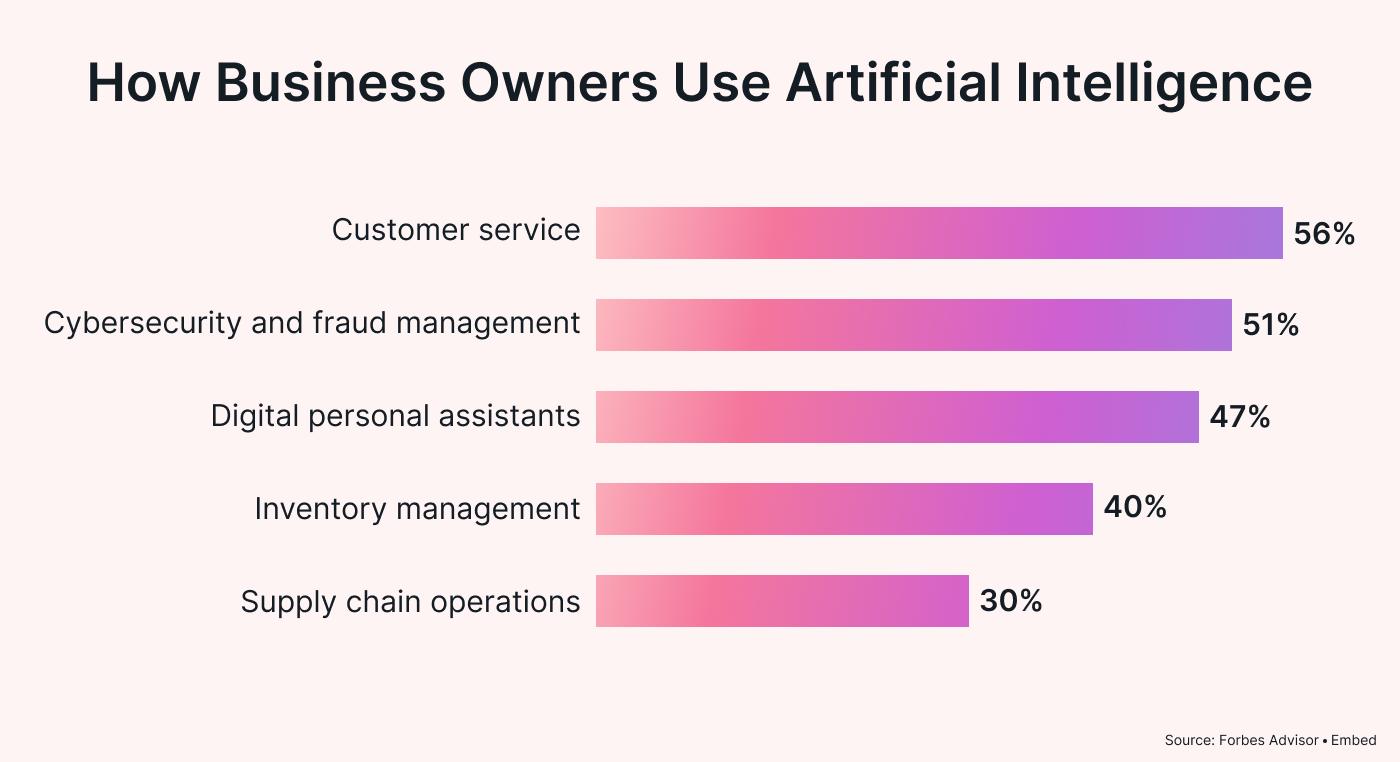 |
- Customer service: This is one of the most popular applications of AI in business, and 56% of business owners state that they use AI in this capacity. Automated planning can be used to schedule customer service appointments, optimize queuing systems, and allocate resources efficiently.
- Cybersecurity and fraud management: Automated planning can help identify patterns and anomalies in data to detect potential cybersecurity threats or fraudulent activities.
- Digital personal assistants: Automated planning is a core driver of digital personal assistants such as Siri, Google Assistant, Amazon Alexa, and Samsung Bixby.
- Inventory management: Automated planning can be used to optimize inventory levels, reorder points, and supply chain logistics based on demand forecasts and historical data.
- Supply chain operations: Similar to inventory management, automated planning plays an important role in optimizing supply chain logistics, including demand forecasting, inventory management, and distribution strategies.
What is an automated planning system?
An automated planning system, or an automated planner, is the system or software that enables the automated planning process. For instance, an AI calendar is an automated planning system that uses AI scheduling algorithms, logical reasoning, and data analysis to manage events and tasks.
How does an automated planner work?
Let’s say you have a complicated scheduling problem to solve. For example, an unexpected meeting crops up, and you have to juggle your already full work calendar to accommodate it. You move a task to another time slot to enter your meeting, but this, in turn, means you'll have to reorganize several other events and tasks. At the same time, you need to make sure that the tasks and events with the highest priority are re-entered accordingly and that all your milestones and deadlines will still be met.
What’s more, this is going to impact your teammate’s timetables in the same way, and they’ll also have to be rescheduled. Bit of a nightmare situation, right? The human brain is going to take some time to solve this problem, involving trial and error and a fair bit of frustration. AI, on the other hand, is going to do it in seconds, using logic and a systematic approach.
The exact mechanics of AI and automated planning are beyond the scope of this article, but we can use a simple model to understand them in a bit more depth. This model identifies three basic elements within the automated planning process. These are the initial state, the goal, and the actions.
Initial State
Using the example of an AI calendar, the initial state would consist of the current timetable of tasks and events. This includes their time, duration, and any dependencies or constraints associated with them. It also includes the details of the unexpected meeting to be scheduled, such as its time and duration.
A constraint is a limitation or requirement that shapes the plan. It includes factors like time blocking for recurring events, task dependencies, and resource constraints. In the context of our example, a resource constraint might mean that a meeting room is only available at certain times.
A dependency refers to a relationship between activities, where the completion of one task is required for the execution of another. Dependencies determine the order and sequencing of actions in a plan. So in this context, an example of a dependency might be that a team brainstorming session must be completed before the design review meeting can take place. Therefore, the design review meeting depends on the completion of the team brainstorming session.
Goal
The goal of the automated planning system in our example would be to allocate a time slot for the unexpected meeting and reschedule the existing events and tasks. Rescheduling must minimize conflicts and consider any constraints and dependencies within the timetables of everyone involved.
Actions
To achieve the goal of scheduling the unexpected meeting and reorganizing existing events and tasks, the automated planner would perform the following sequence of actions:
Analyze the current schedule, considering the time, duration, and dependencies of each event and task.
Assign priorities to events and tasks based on their importance, deadlines, or other factors. It would also consider any constraints related to the unexpected meeting, such as a required attendance or a fixed time frame.
The planner would then generate multiple alternative schedules by considering different combinations and arrangements of events and tasks. It may need to cancel or reschedule existing tasks and events.
Each alternative schedule would be evaluated based on factors such as prioritized tasks and events, potential conflicts, any dependencies, and meeting any constraints. After evaluating all these factors, the automated planner would then select the optimal time slot.
Once the best time slot has been identified, the planner will enter the unexpected meeting and reschedule events and tasks accordingly.
After modifying the schedule, the AI planner would provide all relevant users with the updated schedule and notify them about the changes made.
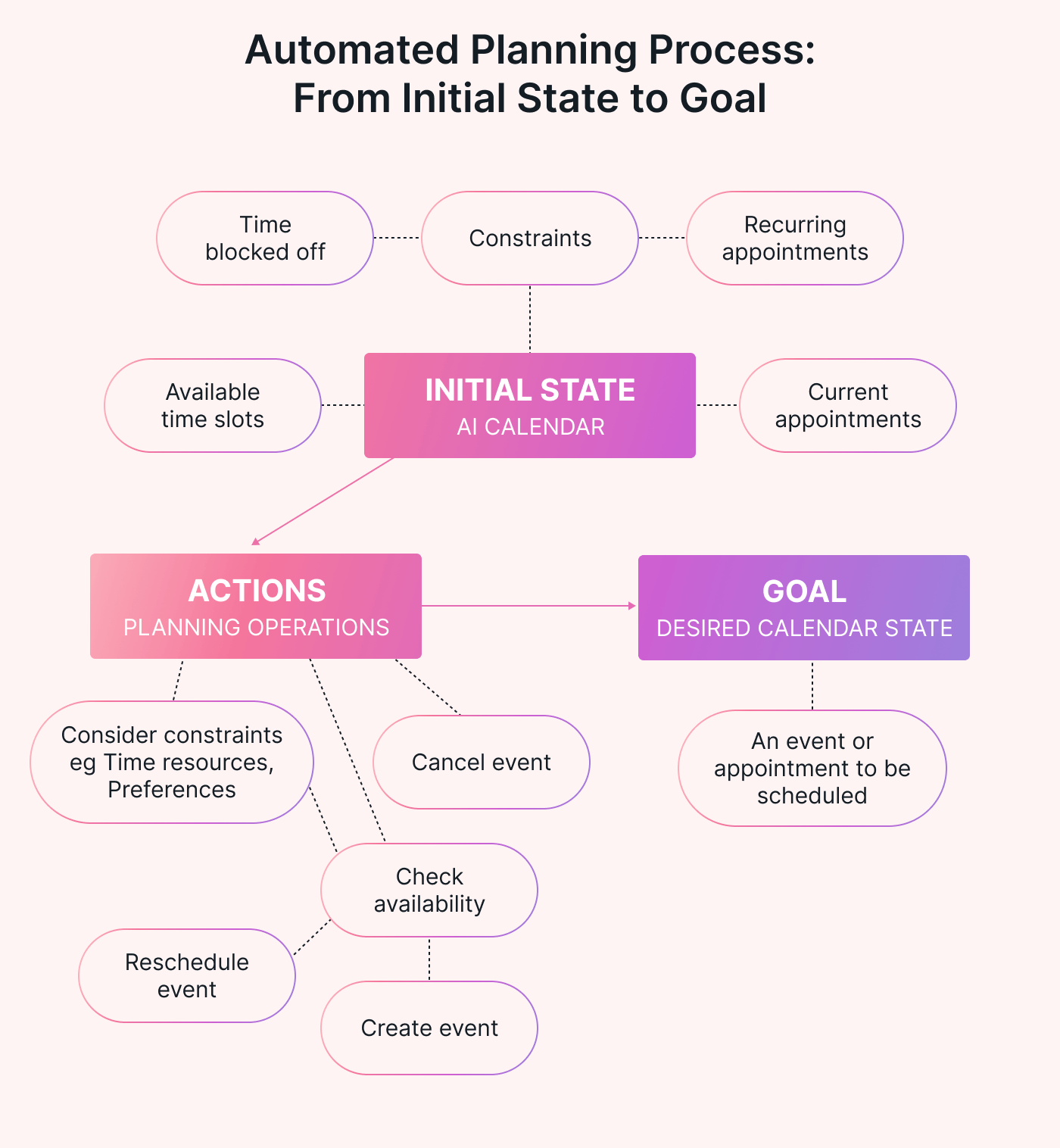 |
If any conflicts or constraints arise because of the new schedule, the system will repeat the planning process until it comes up with an effective solution. It'll evaluate the modified schedule using the same criteria for each iteration, generating alternative solutions, and selecting the best option until a satisfactory resolution is reached.
What are the benefits of automated planning and scheduling?
Optimal use of resources
Automated planning and scheduling can help your organization make the most of all the resources you have available. Using the power of AI algorithms, an automated planner can come up with the most efficient solutions for the allocation of personnel, equipment, and other resources. This increases productivity and reduces waste, ultimately leading to savings in costs.
Time savings
Time is a precious resource in business, and not so surprisingly, 90% of employees from a wide range of industries say better time management would increase productivity in the workplace. There’s little doubt that automated planning and scheduling can provide significant time savings. Tasks that would traditionally take hours or days can now be accomplished in minutes or less. Furthermore, time saved on mundane tasks can be put to much better use. T eam members can focus on higher-value activities, such as creative problem-solving, innovation, and strategic initiatives.
Improved decision-making
Decision-making is easier and more efficient when you have accurate and real-time information. An automated planning system considers all the resources available and any constraints and dependencies that might affect any decisions to be made. It then comes up with alternatives that align with your goals, making decision-making faster, easier, and less prone to errors.
Adaptability and flexibility
Automated planning and scheduling systems are quick and flexible when responding to unexpected events, such as equipment failures or changes in demand. Their ability to automatically adjust schedules and reallocate resources minimizes disruptions to the smooth flow of business operations.
Complexity management
Large-scale scheduling problems can involve numerous interconnected tasks, constraints, and dependencies, which would be challenging and time-consuming for a human planner. Automated planning and scheduling systems can manage this sort of complexity in a fraction of the time and with less risk of error.
Consistency and accuracy
Automated planning and scheduling systems do away with the errors that can occur in manual scheduling. They automatically take account of dependencies, constraints, predefined rules, and business policies so you can depend on the accuracy of scheduling outcomes.
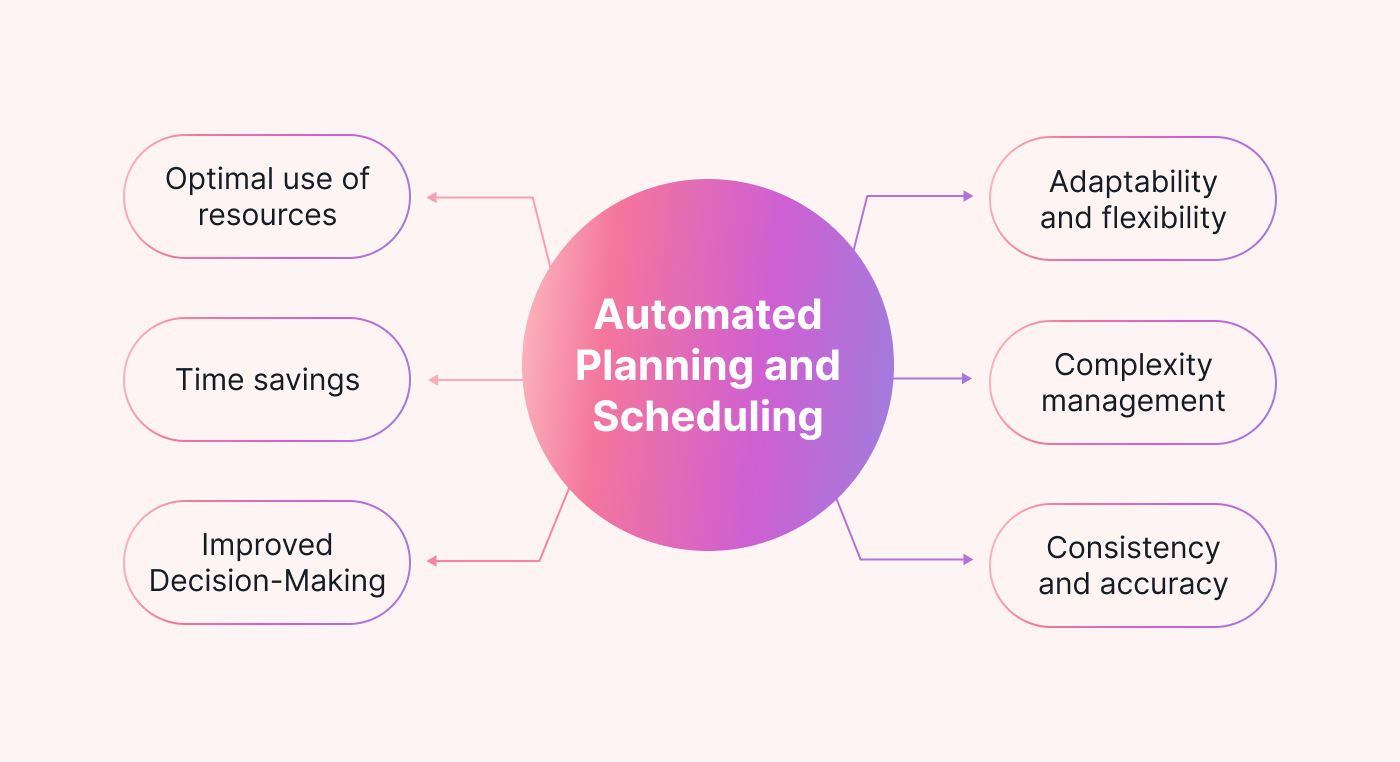 |
What are the applications of automated planning and scheduling?
There’s a wide range of potential uses for automated planning in business and in other environments, and we’ve already touched on some of them. Here are a few more examples:
Task management
Automated planning systems streamline the process of task allocation, scheduling, and prioritization by leveraging advanced planning algorithms. AI planners consider factors such as task dependencies, the availability of resources, and deadlines to generate optimized schedules. They ensure tasks are assigned to the right people in your team, the optimal use of your resources, and that all deadlines are met.
Scheduling
As we’ve already seen, scheduling is easier and more efficient with automated planning, leading to many benefits, such as more streamlined operations and improved productivity.
Project management
Using automated planning in project management has similar advantages to those of its use in task management and scheduling. That is, fast, efficient allocation and scheduling, leading to improved efficiency and productivity.
Logistics and supply chain
Logistics is a complex and competitive business for which automated planning provides several benefits and solutions. For example:
- Automated planning enables the optimal use of resources such as vehicles, warehouses, and personnel.
- It can optimize route planning, load distribution, and inventory management.
- Provides flexible and adaptable responses to changing demands or supply chain complexities.
- Improves visibility and decision-making by providing real-time data analytics.
These advantages lead to improved operational efficiency, cost savings, better customer relations, and stronger overall competitiveness.
Autonomous vehicles
Autonomous vehicles rely on the use of automated planning to make decisions and adapt to changing road conditions. The use of advanced planning algorithms ensures vehicles avoid collisions, select efficient routes, and generally move safely in their environment.
Robotics and manipulation
Robotics and manipulation refer to the process of creating optimized sequences of actions for robots to handle objects and perform tasks independently. The use of automated planning in this process allows robots to plan and carry out complex movements, such as grasping and manipulating objects. Moreover, by using automated planning, robots are capable of extreme precision and accuracy, such as in the assembly of microelectronics or even assisting in surgical procedures.
Resource allocation
The efficient use of resources is essential for any business to remain productive and cost-effective. Automated planning can help in the allocation of resources, for instance, by making sure that tasks are assigned in a way that makes the most of employees’ skills and abilities. Or by helping in the decision-making process of where and how to use machinery and materials efficiently in order to save time and money.
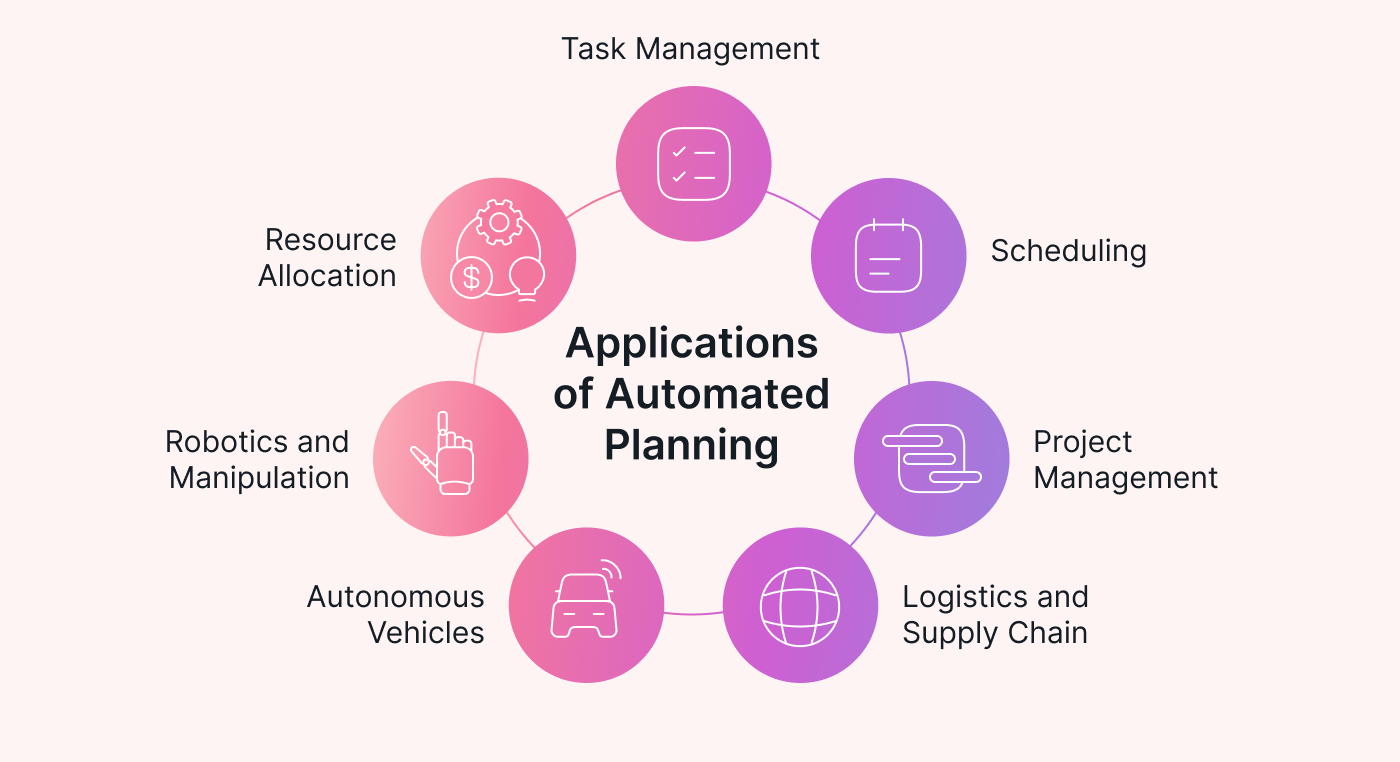 |
There are almost limitless other examples of how automated planning can be put to use, such as in warehouse management, energy grid optimization, disaster response planning, health resource allocation, and traffic management. And the potential uses of automated planning are likely to grow even wider as AI becomes more and more sophisticated.
Motion’s AI Planner
AI and automated planning are complex topics, but hopefully, we’ve provided a little more insight into the way automated planning systems work.
It’s not an overstatement to say that AI and automated planning can revolutionize efficiency in businesses and other areas of its application, and who knows where this will lead in the future. Many working in the field of AI state that it’s hard to imagine its capabilities even in just a few years’ time. So now’s a good time to start making use of this technology and maintain competitiveness both now and in the future.
To experience the power of automated planning with Motion’s AI planner, why not take advantage of our free 7-day trial?





